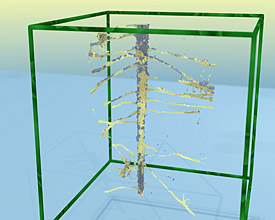Press release from November 26, 2009
When roots lose contact
Drought-related shrinking processes detected in living roots in the soil for the first time
Halle/Saale. Plant roots can shrink as a result of water deficit and lose contact with the surrounding soil. This effect has been suspected for a long time, but has only now been demonstrated for a fact with the help of x-ray tomography. The formation of an air gap could initially help plants prevent impending water losses when the soil dries out, say scientists from the Helmholtz Centre for Environmental Research (UFZ) writing in the Vadose Zone Journal.

Roots of a White Lupin imaged with X-ray tomography. With the help of X-ray tomograhy, UFZ researchers demonstrated a drought-related shrinkage
of plant roots and as a result the formation of an air gap between the roots and the surrounding soil.
Source: Dr. Ulrich Weller/UFZ
For their study, the researchers investigated roots of the White Lupin (Lupinus albus L.) in sandy soil for a month, examining changes to the soil-root interface as the soil dried out and was irrigated, using x-ray tomography. Their research uncovered air gaps that formed as a result of root shrinkage during dry periods. "These interactions between soil structure and biological activity make the soil-root interface a complex and dynamic biomaterial whose importance has just begun to be understood," explains Andrea Carminati of the UFZ.
After irrigation, the roots in the experiment swelled, partially refilling the air gaps, but contact in the older part of the taproot was
not fully re-established. Does this mean that severe drought can permanently impair the contact between roots and the soil, thereby reducing
a plant’s uptake of water and nutrients? Or can the plants re-establish the contact? These questions are of great significance for
agriculture, in view of climate change and the drier summers that are expected in the north-east of Germany. This is why the soil
researchers at the UFZ intend to continue with their x-ray investigations of plant root interactions.
Tilo Arnhold
Publication
Carminati, A., Vetterlein, D., Weller, U., Vogel, H. J., Oswald, S. E. (2009):
When roots lose contact
Vadose Zone J. 8 (2), 805-809
http://dx.doi.org/10.2136/vzj2008.0147
Further information:
Helmholtz Centre for Environmental Research (UFZ)
Dr. Andrea Carminati, Prof. Dr. Sascha Oswald
Phone: +49 (0)341 235 1996 /-1253
Dr. Andrea Carminati
Prof. Dr. Sascha Oswald
and
PD Dr. Doris Vetterlein, Dr. Ulrich Weller, PD Dr. Hans-Jörg Vogel
Department of Soil Physics
Phone +49 (0)345 558 5415 /-5411, /-5403
PD Dr. Doris Vetterlein
Dr. Ulrich Weller
PD Dr. Hans-Jörg Vogel
or
Helmholtz Centre for Environmental Research (UFZ)
Press office
Tilo Arnhold
Phone +49 (0)341 235 1269
presse@ufz.de
At the Helmholtz Centre for Environmental Research (UFZ) scientists research the causes and consequences of far-reaching
environmental changes. They study water resources, biological diversity, the consequences of climate change and adaptation possibilities,
environmental and biotechnologies, bio energy, the behaviour of chemicals in the environment and their effect on health, as well as
modelling and social science issues. Their guiding research principle is supporting the sustainable use of natural resources and helping
to secure these basic requirements of life over the long term under the influence of global change. The UFZ employs 930 people at its sites in
Leipzig, Halle and Magdeburg. It is funded by the German government and by the states of Saxony and Saxony-Anhalt.
The Helmholtz Association helps solve major, pressing challenges facing society, science and the economy with top scientific
achievements in six research areas: Energy, Earth and Environment, Health, Key Technologies, Structure of Matter, Transport and Space.
With 28,000 employees in 15 research centres and an annual budget of around EUR 2.4 billion, the Helmholtz Association is Germany’s largest
scientific organisation. Its work follows in the tradition of the great natural scientist Hermann von Helmholtz (1821-1894).
